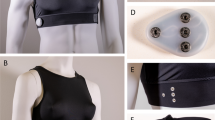Abstract
Advancement in wearable healthcare technology allows a digital revolution in healthcare that is intended to extend life length and improve life quality. Until now, numerous efforts for wearable device-mediated healthcare systems have been focused on achieving accurate monitoring and robust operation by developing cutting-edge biosensors rather than by optimizing the placement position of well-established biosensors. Much therefore still remains unclear about the optimal position involved in biosensor placement. This leads to the need for systematic optimization of biosensor placement position. Here, the placement positions of 2 biosensor arrays (i.e., ECG-TC array and PPG-TC array) are optimized to achieve high-accuracy measurement and high-robustness operation in monitoring both body temperature and heart rate, which are commonly measured as core vital signs in wearable healthcare systems. The ECG-TC array is composed of an electrocardiography (ECG) sensor (for heart rate measurement) and a thermocouple (TC) sensor (for body temperature measurement) while the PPG-TC array consists of a photoplethysmography (PPG) sensor and a TC sensor. 34 major parts in the human body are scored in terms of monitoring accuracy (MA) and operational robustness (OR), which results in the MA index and OR index. Next, the body part having the maximum value, calculated as the product of two indices, is determined as the optimal placement position. The MA index is calculated from the signal magnitude of each biosensor and the OR index is assessed by quantifying the user accessibility, skin extensibility, and perspiration weight of each body part. Our study shows that the ECG-TC array needs to be placed on armpit, chest, and back thigh and the PPG-TC array on thumb, finger, and ear. This means the optimal placement position of biosensor-based wearable healthcare systems is affected by a combination of different biosensors. The findings of this study are expected to contribute to better understanding of biosensors and lead to further improvement in wearable healthcare devices.
Similar content being viewed by others
References
Department of Economic and Social Affairs, World Population Ageing 2017 Highlights, United Nations, New York, USA (2017).
B. Farahani, F. Firouzi, V. Chang, M. Badaroglu, N. Constant and K. Mankodiya, Towards fog-driven IoT ehealth: promises and challenges of IoT in medicine and healthcare, Future Generation Computer Systems, 78 (2) (2018) 659–676.
E. Spanò, S. D. Pascoli and G. Iannaccone, Low-power wearable ECG monitoring system for multiple-patient remote monitoring, IEEE Sensors Journal, 16 (13) (2016) 5452–5462.
E. Nemati, M. J. Deen and T. Mondal, A wireless wearable ECG sensor for long-term applications, IEEE Communication Magazine, 50 (1) (2012) 36–43.
T. Tamura, Y. Maeda, M. Sekine and M. Yoshida, Wearable photoplethysmographic sensors—past and present, Electronics 2014, 3 (2) (2014) 282–302.
G. Yoon, J. Y. Lee, K. J. Jeon, K.-K. Park, H. S. Yeo, H. T. Hwang, H. S. Kim and I.-D. Hwang, Multiple diagnosis based on photoplethysmography: Hematocrit, SpO2, pulse, and respiration, Optics in Health Care and Biomedical Optics: Diagnostics and Treatment, 4916 (2002) 185–188.
S. Nakata, T. Arie, S. Akita and K. Takei, Wearable, flexible and multifunctional healthcare device with an ISFET chemical sensor for simultaneous sweat pH and skin temperature monitoring, American Chemical Society Sensors, 2 (3) (2017) 443–448.
A. J. Casson, D. C. Yates, S. J. M. Smith, J. S. Duncan and E. Rodriguez-Villegas, Wearable electroencephalography, IEEE Engineering in Medicine and Biology Magazine, 29 (3) (2010) 44–56.
S. P. Nichols, A. Koh, W. L. Storm, J. H. Shin and M. H. Schoenfisch, Biocompatible materials for continuous glucose monitoring devices, Chemical Reviews, 113 (4) (2013) 2528–2549.
C. Setz, B. Arnrich, J. Schumm, R. L. Marca, G. Tröster and U. Ehlert, Discriminating stress from cognitive load using a wearable EDA device, IEEE Transactions on Information Technology in Biomedicine, 14 (2) (2010) 410–417.
F. A. Elhaj, N. Salim, A. R. Harris, T. T. Swee and T. Ahmed, Arrhythmia recognition and classification using combined linear and nonlinear features of ECG signals, Computer Methods and Programs in Biomedicine, 127 (2016) 52–63.
K. S. Kock and J. L. B. Marques, Use of photoplethysmography to predict mortality in intensive care units, Vascular Health and Risk Management, 14 (2018) 311–320.
J. Xiong, Z. Lian, X. Zhou, J. You and Y. Lin, Potential indicators for the effect of temperature steps on human, Energy and Buildings, 113 (2016) 87–98.
J. Sztajzel, Heart rate variability: a noninvasive electrocardiographic method to measure the autonomic nervous system, Swiss Medical Weekly, 134 (2004) 514–522.
P. Laguna, N. V. Thakor, P. Caminal, R. Jané, H. R. Yoon, A. A. Bayés de Luna, V. Marti and J. Guindo, New algorithm for QT interval analysis in 24-hour holter ECG: Performance and applications, Medical & Biological Engineering & Computing, 28 (1) (1990) 67–73.
J. A. Dempsey, M. Amann, L. M. Romer and J. D. Miller, Respiratory system determinants of peripheral fatigue and endurance performance, Medicine & Science in Sports & Exercise, 40 (3) (2008) 457–461.
K. B. Laupland, Fever in the critically ill medical patient, Critical Care Medicine, 37 (7) (2009) 273–278.
J. Sakuma, D. Anzai and J. Wang, Performance of human body communication-based wearable ECG with capacitive coupling electrodes, Healthcare Technology Letters, 3 (3) (2016) 222–225.
U. Satija, B. Ramkumar and M. S. Manikandan, A new automated signal quality-aware ECG beat classification method for unsupervised ECG diagnosis environments, IEEE Sensors Journal, 19 (1) (2019) 277–286.
F. N. Wilson, A. G. Macleod and P. S. Barker, The potential variations produced by the heart beat at the apices of Einthoven’s triangle, American Heart Journal, 7 (2) (1931) 207–211.
C. J. Smith and G. Havenith, Body mapping of sweating patterns in male athletes in mild exercise-induced hyper-thermia, European Journal of Applied Physiology, 111 (7) (2011) 1391–1404.
K. A. Holbrook and G. F. Odland, Regional differences in the thickness (cell layers) of the human stratum corneum: an ultrastructural analysis, Journal of Investigative Dermatology, 62 (4) (1974) 415–422.
H. H. Pennes, Analysis of tissue and arterial blood temperatures in the resting human forearm, Journal of Applied Physiology, 1 (2) (1948) 93–122.
F. E. Cormia and V. Kuykendall, Studies on sweat retention in various dermatoses, American Medical Association Archives of Dermatology, 71 (4) (1995) 425–435.
Acknowledgments
This research is performed based on the cooperation with Inha University-LIG Nex1 Cooperation (Y18-060) and partly supported by Basic Science Research Program through the National Research Foundation of Korea (NRF) funded by the Ministry of Science and ICT (NRF-2017R1A2B4010300).
Author information
Authors and Affiliations
Corresponding author
Additional information
Recommended by Editor Chongdu Cho
Seulki Ha is a graduate student of the Department of Mechanical Engineering, Inha University, Incheon, Korea. He received the B.S. degree in biological science, Inha University in 2019. His research interests include bioinspired engineering.
Sangheon Park is a graduate student of the Department of Mechanical Engineering, Inha University, Incheon, Korea. He received the B.S. degree in mechanical engineering, Inha University in 2017. His research interests include biomimetic nano structure.
Hyeon Cheol Lim is a graduate student of the Department of Mechanical Engineering, Inha University, Incheon, Korea. He received the B.S. degree in the Department of Mechanical Engineering from Inha University in 2018. His research interests are composite material, finite element analysis (FEA).
Seung Ho Baek is a Chief Research Engineer of LIG Nex1 Co., Ltd., Seongnam, Korea. He received his B.S. degree in information and communications engineering from Hankuk University of Foreign Studies, Yongin, Korea, in 2002; the M.S. degree in computer and information communications from Hankuk University of Foreign Studies, Yongin, Korea, in 2004. His research interests include sensor network, unattended ground sensor, and wireless communication.
Do Kyoung Kim is a Chief Research Engineer of LIG Nex1 Co., Ltd., Seongnam, Korea. He received the B.S. degree in aeronautical information & telecommunication engineering, Korea Aerospace University, Goyang, Korea, in 1996; the M.S. degree in management of technology from Korea University, Seoul, Korea, in 2016. His research interests include communication engineering, wireless mobile communication, and video signal processing.
Sang-Hee Yoon received the B.S. degree in mechanical design and production engineering from Yonsei University at Seoul, Korea, in 2001; the M.S. degree in mechanical engineering from Korea Advanced Institute of Science and Technology, Daejeon, Korea, in 2003; and the Ph.D. degree in mechanical engineering from University of California at Berkeley, in 2010. From 2003 to 2007, he was a Researcher of Agency for Defense Development, Daejeon, Korea. During 2010–2012, he worked as a Postdoctoral Fellow of Wyss Institute for Biologically Inspired Engineering, Harvard University. In March 2013, he joined Inha University, where he is currently an Associate Professor with the Department of Mechanical Engineering. His research interests are focused on body mechanics, bioinspired engineering, and human-machine interface.
Rights and permissions
About this article
Cite this article
Ha, S., Park, S., Lim, H. et al. The placement position optimization of a biosensor array for wearable healthcare systems. J Mech Sci Technol 33, 3237–3244 (2019). https://doi.org/10.1007/s12206-019-0619-0
Received:
Revised:
Accepted:
Published:
Issue Date:
DOI: https://doi.org/10.1007/s12206-019-0619-0




